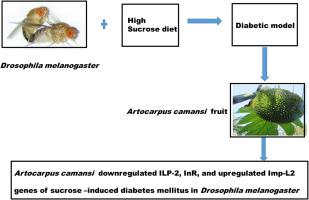Comparative Biochemistry and Physiology C: Toxicology & Pharmacology ( IF 3.9 ) Pub Date : 2021-04-15 , DOI: 10.1016/j.cbpc.2021.109041 Jamiyu Ayodeji Saliu 1 , Ayobami Matthew Olajuyin 2 , Aderopo Akinnubi 1

|
Diabetes mellitus continues to be a menace, being one of the five major causes of death in the world. In this study, the common fruit fly, Drosophila melanogaster, a well-studied genetic model organism for understanding molecular mechanisms of human diseases, and Artocarpus camansi (breadnut), an underutilized fruit, was used. This study was aimed at investigating the antihyperglycemic potentials of Artocarpus camansi fruit in sucrose-induced diabetic Drosophila melanogaster. Phytochemical screening was carried out after the fruit has been pulverized and freeze-dried. Total phenol content and total flavonoid content were carried out in vitro on the aqueous extract of Artocarpus camansi, and the result obtained showed that its phenol content is low, and its flavonoid content increases at increasing concentrations. Alpha-amylase inhibitory activity was carried out in vivo on sucrose-induced diabetic Drosophila melanogaster tissue. Gene expression profiling of Insulin-like peptide-2 (ILP-2), Insulin-like receptor (InR) and Ecdysone inducible gene L2 (Imp-L2) was carried out on trizol homogenate of Drosophila melanogaster tissue. In this study, Drosophila melanogaster was divided into nine groups. Group1 served as the basal control as they were fed with normal basal diet, group II served as the negative control which were fed with basal diet and 0.5 mL sucrose/100 mL distilled water, group III served as the positive control which were fed with basal diet 0.5 mL sucrose/100 mL distilled water and metformin, groups IV and V which were fed with basal diet and 0.1 and 1% Artocarpus camansi respectively, groups VI and VII were fed with basal diet, sucrose and 0.1 and 1% Artocarpus camansi respectively, groups VIII and IX served the purpose of the synergistic effect which were fed with basal diet, sucrose, metformin and 0.1 and 1% Artocarpus camansi respectively. All the groups were left for seven days. The experiment was conducted for 3 months and the fruit fly meals were changed every 5 days. Gene expression profiling results showed that the dietary inclusion of fruit downregulated the expression of ILP-2 and InR and upregulated the expression of Imp-L2 when the diabetic group were compared with the normal control. The results suggest that Artocarpus camansi fruit could possess antihyperglycemic properties and its use as a nutraceutical in the alleviation of diabetes should be encouraged.
中文翻译:

Artocarpus camansi对蔗糖诱导的黑腹果蝇糖尿病ILP-2、InR和Imp-L2基因的调节作用
糖尿病仍然是一种威胁,是世界上五种主要死亡原因之一。在这项研究中,使用了常见的果蝇 Drosophila melanogaster,一种经过充分研究的遗传模型生物,用于了解人类疾病的分子机制,以及Artocarpus camansi(面包果),一种未充分利用的水果。本研究旨在研究红果果在蔗糖诱导的糖尿病黑腹果蝇中的抗高血糖潜力。将果实粉碎并冷冻干燥后进行植物化学筛选。对黄果仁水提物进行体外总酚含量和总黄酮含量的测定,所得结果表明其苯酚含量较低,且其黄酮含量随浓度增加而增加。α-淀粉酶抑制活性在体内对蔗糖诱导的糖尿病黑腹果蝇组织进行。的基因表达谱胰岛素样肽-2(ILP-2 ),胰岛素样受体(INR)和蜕皮激素诱导的基因L2(IMP-L2)中的溶液于TRIZOL的匀浆进行果蝇组织。在这项研究中,黑腹果蝇被分成九组。第1组为基础对照,饲喂正常基础日粮,第II组作为阴性对照,饲喂基础日粮和0.5 mL蔗糖/100 mL蒸馏水,第III组作为阳性对照,饲喂基础日粮。饮食0.5 mL蔗糖/ 100毫升蒸馏水和二甲双胍,组IV和V分别饲喂基础日粮和0.1和1%的白桂camansi分别,组VI和VII饲喂基础日粮,蔗糖和0.1和1%的白桂camansi分别,第 VIII 和第 IX 组起到了协同作用的目的,它们用基础日粮、蔗糖、二甲双胍和 0.1% 和 1%菠萝蜜喂养分别。所有的组都被放置了 7 天。实验进行了 3 个月,每 5 天更换一次果蝇餐。基因表达谱分析结果表明,当糖尿病组与正常对照组相比时,饮食中加入水果可下调ILP-2和InR的表达,上调Imp-L2的表达。结果表明,Artocarpus camansi果实具有抗高血糖特性,应鼓励将其用作缓解糖尿病的营养食品。


















































 京公网安备 11010802027423号
京公网安备 11010802027423号